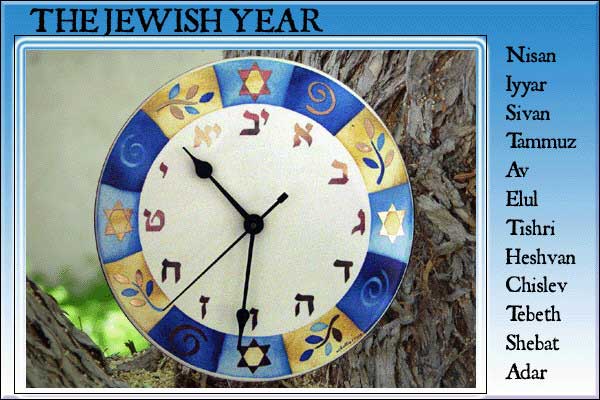When studying the Old Testament, dates can be a source of confusion, especially when they switch between the Jewish name and the Babylonian name in the same story. Here are my reference tables.
| Sacred# | Civic# | Jewish | # of days | Julian | Season |
| 1 | 7 | Nisan | 30 | Mar/Apr | barley harvest |
| 2 | 8 | Iyyar (Lyar) | 29 | Apr/May | general harvest |
| 3 | 9 | Sivan | 30 | May/Jun | wheat harvest |
| 4 | 10 | Tammuz (Tammiz) | 29 | Jun/Jul | almonds ripe |
| 5 | 11 | Ab | 30 | Jul/Aug | grape, fig, olive |
| 6 | 12 | Elul | 29 | Aug/Sep | grape, fig, olive |
| 7 | 1 | Tishri | 30 | Sep/Oct | early rain, plowing |
| 8 | 2 | Heshvan | 29/30 | Oct/Nov | wheat barley sowing |
| 9 | 3 | Kislev (Chislev) | 30/29 | Nov/Dec | rainy months |
| 10 | 4 | Tebeth | 29 | Dec/Jan | rainy months |
| 11 | 5 | Shebat | 30 | Jan/Feb | rainy months |
| 12 | 6 | Adar | 29/30 | Feb/Mar | almonds blooming |
| . | . | . | Total: 354 | . | . |
Hebrew months were alternately 30 and 29 days long. Their year had 354 days (shorter than ours). The year was divided into 12 lunar months, with a 13th month 7 times in every 19 years. Every three years (7 times in 19 years) an extra 29-day month called Veadar was added between the Jewish months of Adar and Nisan.
The sacred year began in the spring. The civil year began in the fall. The 7th Sacred month was the 1st civil month.
| Sacred# | Jewish Name | Babylonian Name | Macedonian Name |
| 1 | Nisan | Nisanu | Artemisios |
| 2 | Iyyar | Aiaru | Daisios |
| 3 | Sivan | Simanu | Panemos |
| 4 | Tammuz | Duzu | Loos |
| 5 | Ab | Abu | Gorpiaios |
| 6 | Elul | Ululu | Hyperbereatios |
| 7 | Tishri | Tashritu | Dios |
| 8 | Hesvan | Arahsamnu | Appellaios |
| 9 | Kislev | Kislimu | Audynaios |
| 10 | Tebeth | Tebetu | Peritios |
| 11 | Shebat | Shabatu | Dystros |
| 12 | Adar | Addaru | Xanthikos |
Further Reference:
Hebrew4 Christians: Jewish Holidays
Bible-History.com: Jewish Calendar
Barnes Bible Charts: Hebrew Calendar
Wikipedia: Hebrew Calendar
Jewish Calendar Sacred and Civil Years
Time&Date: Jewish Calendar
Jewish Feasts
For more information see: Hebrew4Christians
Passover (Pesach) – Nisan
Unleavened Bread (Chag Hamotzi) – Nisan
First Fruits (Yom habikkurim) – Nisan
Pentecost (Shavu’ot) – Sivan
Trumpets (Yom Teru’ah) – Tishri
Atonement (Yom Kippur) – Tishri
Tabernacles (Sukkot) – Tishri
Introduction to Jewish Feasts
Photo from Bible-History.com and used here under Flickr Creative Commons.

